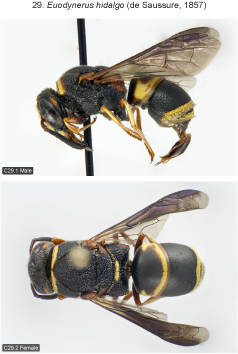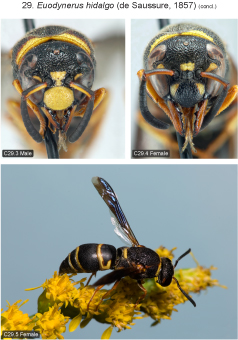
| Home | Table of contents | Keys | Species list | Glossary | Image data | PDF | Cite this article | Feedback | Updates |
Identification Atlas of the Vespidae (Hymenoptera, Aculeata) of the northeastern Nearctic region
CJAI 05, February 19, 2008
doi: 10.3752/cjai.2008.05
Matthias Buck, Stephen A. Marshall, and David K.B. Cheung
Department of Environmental Biology, University of Guelph, Guelph, Ontario, Canada N1G 2W1
Next species | Previous species | Key
29. Euodynerus hidalgo (de Saussure, 1857)
Figs B5.21, 55; C29.1–5.

|

|
Species recognition. This distinctive species is immediately recognised by the reflexed, lamellate, translucent apical margins of terga 2 and 3. In other species the margin of tergum 3 is never reflexed. Tergum 2 has a reflexed apical margin in a few other species, where it can be either thickened (E. auranus, E. sp. G, E. castigatus) or thin and more or less translucent (some species of E. foraminatus-group).
Variation. Fore wing length 8–9 mm (♂♂), 8.5–10.5 mm (♀♀). Interantennal spot in male extending to clypeus, sometimes interrupted at middle by transverse black stripe. Yellow stripe along lower inner orbit ending at level of antennae in female, usually continued to clypeus in male but often interrupted at level of antennae. Yellow markings of head sometimes slightly suffused with reddish in female, postocular spot usually completely ferruginous, sometimes (more often in male) with yellow centre. Yellow pronotal band usually extending to humeral angle, rarely restricted to middle third of pronotum (laterally replaced by ferruginous), with or without narrow ferruginous posterior border, ferruginous area rarely broad and extending to middle of pronotum posteriorly. Dorsal spot of mesopleuron small, rarely absent in female (often absent in male), rarely suffused with ferruginous. Scutellum rarely with a pair of small ferruginous spots near lateral margins. Metanotum with transverse yellow band usually well developed, rarely obscure. Ferruginous propodeal spots present or absent on upper surface, occasionally large, especially in male. Metasomal terga 1–3 with yellow apical fasciae, in male medial remnant of fascia often present on tergum 4. Tergum 1 with an often very narrow ferruginous area bordering yellow apical fascia, more conspicuous laterally. Sternum 2 with posterolateral yellow spots in female (rarely with complete but obscure fascia); sterna 2(–4) of male with complete fascia or posterolateral spots, gradually less developed on more posterior segments, sometimes brownish and ill-defined.
Distribution. Canada: newly recorded for ON and BC. Transcontinental in U.S., in the east north to MA, NY, PA, OH (Bequaert 1937, Krombein 1979). Mexico: south to Morelos and Jalisco (Rodríguez-Palafox 1996). The northeastern subspecies is boreoorientalis (Bequaert, 1937). The nominate subspecies and spp. viereckii (Cameron, 1909) occur in the west.
Biology. Nests in borings in wood and uses firmly agglutinated sand as cell partitions and closing plugs. Specimens from the western part of its range (which have been attributed to different subspecies) were found to nest in mud cells (probably of an anthophorine bee) within a burrow in a clay bank, in old Sceliphron (Sphecidae) nests, or in mud nests built in an abandoned Polistes nest. Prey are Pyralidae (Phycitinae) caterpillars (Krombein 1967, 1979).
Next species | Previous species | Key
| Home | Table of contents | Keys | Species list | Glossary | Image data | PDF | Cite this article | Feedback | Updates |
